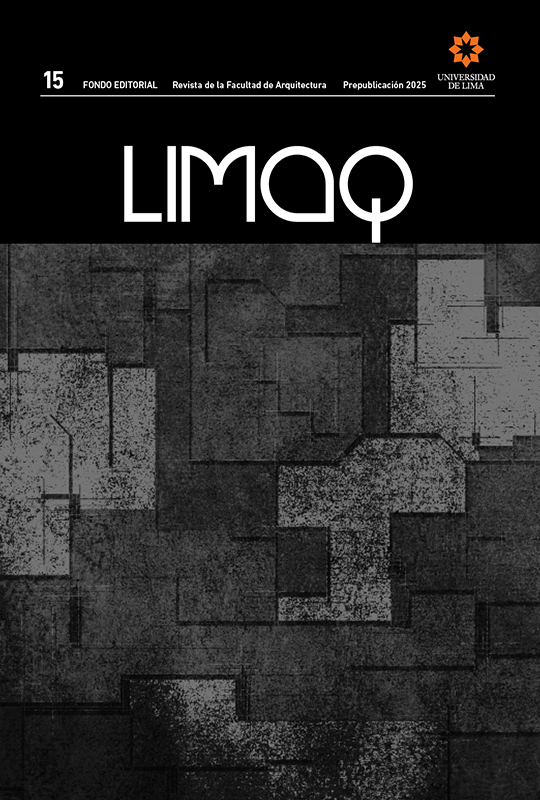The Nature of Space in the Americas: Realizing a Non-Eurocentric and Non-Anthropocentric Theory or Theories for Architecture and Urbanism.
DOI:
https://doi.org/10.26439/limaq2025.n015.7282Keywords:
nature, space, America, Abiayala, indigeneity, EurocentrismAbstract
This essay explores recent scholarship devoted to decolonizing theories of architecture and urbanism and focuses on how alternative perspectives of the relationships between humans and the rest of the natural world can help build other, more inclusive, intellectual frameworks for understanding cultural landscapes. It argues that recognizing the patterns of spatial occupation of the Americas by various Indigenous peoples prior to colonization is a useful first step towards moving outside obstinate ways of knowing and shaping the world. The essay begins by challenging the names of things, since stepping outside Eurocentricism and anthropocentricism requires renaming and, consequently, reconceiving many things. Notably, the word nature must be dismantled as an inherently Eurocentric concept. For example, this essay describes how thinking differently about how Indigenous peoples manipulated the plants and animals around them to produce food and other useful materials can lead to other ways of thinking about urbanism. Finally, this essay explores the tendency of Eurocentric theories in many disciplines to be anthropocentric (as opposed to anthropomorphic) and to associate colonization and its dark side, modernism, with the inevitable, progressive improvement of humankind.
Downloads
References
Arias, A. (2018). From Indigenous literatures to Native American and Indigenous theorists: The makings of a grassroots decoloniality. Latin American Research Review, 53(3), 613–626. https://doi.org/10.25222/larr.181
Bhambra, G. K. (n.d.). Reframing colonialism and modernity: An endeavour through sociology and literature. The Global South Project at Cornell University. http://www.globalsouthproject.cornell.edu/reframing-colonialism-and-modernity.html
Brown, F. L. (2016). The city is more than human: An animal history of Seattle. University of Washington Press. https://www.perlego.com/book/723876/the-city-is-more-than-human-an-animal-history-of-seattle-pdf
Candiani, S. (2014). Dreaming of dry land: Environmental transformation in colonial Mexico City. Stanford University Press. https://history.princeton.edu/about/publications/dreaming-dry-land-environmental-transformation-colonial-mexico-city
Cardinal-Pett, C. (2015). A history of architecture and urbanism in the Americas. Routledge. https://doi.org/10.4324/9781315691817
Clarke, A. J. (2016). Design for development, ICSID and UNIDO: The anthropological turn in 1970s design. Journal of Design History, 29(1), 43–57. https://doi.org/١٠.١٠٩٣/jdh/epv٠٢٩
Denevan, W. M. (1992). The pristine myth: The landscape of the Americas in 1492. Annals of the Association of American Geographers, 82(3), 369–385. http://www.jstor.org/stable/2563351
Dym, J. (n.d.). [Review of the book Dreaming of dry land: Environmental transformation in colonial Mexico City, by V. S. Candiani]. Amazon. https://www.amazon.com/Dreaming-Dry-Land-Environmental-Transformation/dp/0804788057
Holbraad, M., & Viveiros de Castro, E. (2016). Ideas of savage reason: Glass Bead in conversation with Martin Holbraad and Eduardo Viveiros de Castro. Glass Bead. https://www.glass-bead.org/article/ideas-of-savage-reason-glass-bead-in-conversation-with-martin-holbraad-and-eduardo-viveiros-de-castro/?lang=enview
Illich, I. (1985). H2O and the waters of forgetfulness: Reflections on the historicity of stuff. Dallas Institute of Humanities and Culture. https://www.amazon.com/H2O-Waters-Forgetfulness-Reflections-Historicity/dp/0911005064
Keme, E. (2018). For Abiayala to live, the Americas must die: Toward a transhemispheric Indigeneity (A. Coon, Trans.). Native American and Indigenous Studies, 5(1), 42–68. https://doi.org/10.1353/nai.2018.a704738
Lara, F. L. (2024). Spatial theories for the Americas: Counterweights to five centuries of Eurocentrism. University of Pittsburg Press. https://upittpress.org/books/9780822948339/
Latour, B. (2004). Politics of nature: How to bring the sciences into democracy (C. Porter, Trans.). Harvard University Press. https://doctoradohumanidades.wordpress.com/wp-content/uploads/2015/04/latour-politics-of-nature.pdf
Leiss, W. (1974). The domination of nature. McGill-Queen’s University Press. https://www.mqup.ca/domination-of-nature--the-products-9780228017257.php
Linton, J. (2010). What is water? The history of a modern abstraction. UBC Press. https://www.ubcpress.ca/what-is-water
Lorde, A. (1984). Sister outsider: Essays and speeches. New York University Press. https://books.google.com.pe/books/about/Sister_Outsider.html?id=kE3ek_-FGWgC&redir_esc=y
McNeill, W. H. (1995). The Rise of the West after twenty-five years. In S. K. Sanderson (Ed.), Civilizations and world-systems: Studying world-historical change (pp. 303-319). AltaMira Press.
Mundy, B. E. (2015). The death of Aztec Tenochtitlan, the life of Mexico City. University of Texas Press. https://utpress.utexas.edu/9781477317136/
Pádua, J. A. (2010). The theoretical foundations of environmental history. Estudos Avançados, 24(68), 88. https://www.scielo.br/j/ea/a/Q4JBvrMMzw6gBvWhsshnKXN/?format=pdf&lang=en
Princeton University. (n.d.). Vera S. Candiani. Princeton-Mellon Initiative in Architecture, Urbanism & the Humanities. https://arc-hum.princeton.edu/people/vera-candiani
Scarce, R. (2000). Fishy business: Salmon, biology, and the social construction of nature. Temple University Press. https://books.google.com.pe/books/about/Fishy_Business.html?id=M9jLp13q9jUC&redir_esc=y
Simmons, I. G. (1993). Interpreting nature: Cultural constructions of the environment. Routledge. https://www.routledge.com/Interpreting-Nature-Cultural-Constructions-of-the-Environment/Simmons/p/book/9780415097062?srsltid=AfmBOoqW-23FuOWmqv_w8I9CzN12yH4izBoStom3meqCna6-ZAbPMG41
Soluri, J., Leal, C., & Pádua, J. A. (2018). A living past: Environmental histories of modern Latin America. Berghahn Books. https://doi.org/10.3167/9781785333903
Sörlin, S., & Warde, P. (2007). The problem of the problem of environmental history: A re-reading of the field. Environment History, 12(1), 107–130. https://www.jstor.org/stable/25473035
Stender, M. (2016). Towards an architectural anthropology—What architects can learn from anthropology and vice versa. Architectural Theory Review, 21(1), 27–43. https://doi.org/10.1080/13264826.2016.1256333
Viveiros de Castro, E. (1998). Cosmological deixis and Amerindian perspectivism. The Journal of the Royal Anthropological Institute, 4(3), 469–488. https://doi.org/10.2307/3034157



